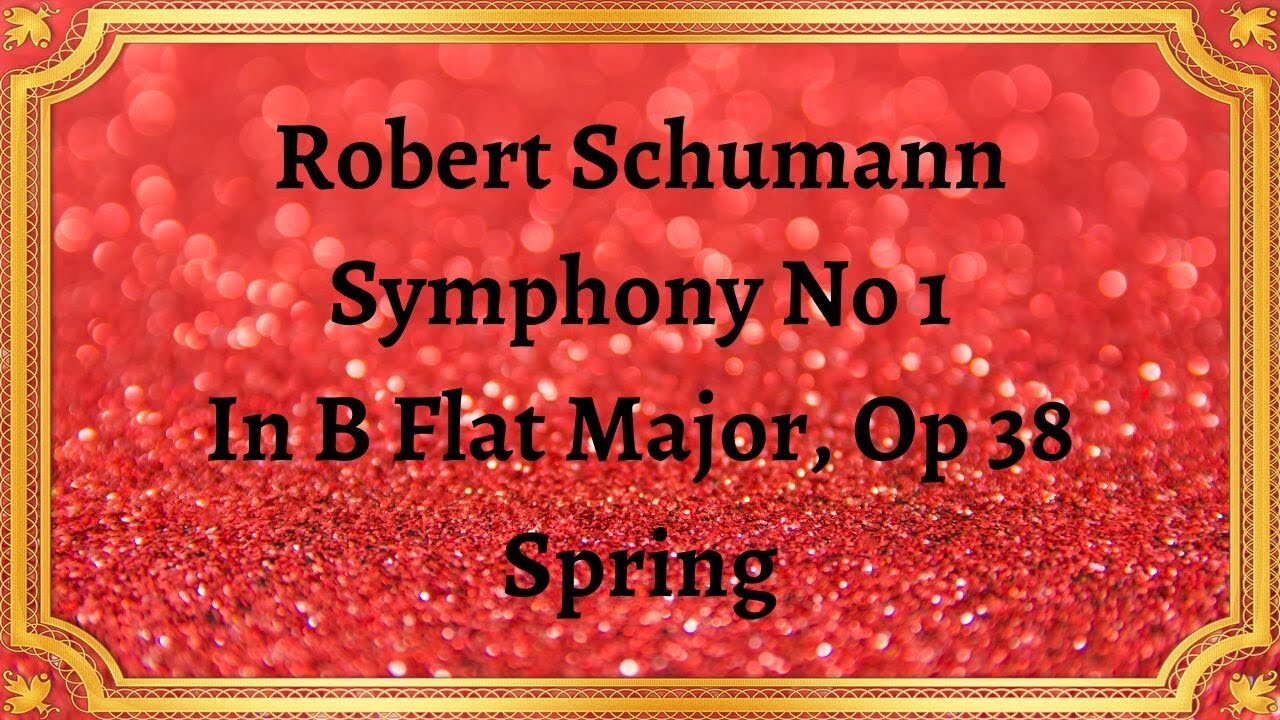Premium Only Content

Robert Schumann Symphony No 1 In B Flat Major, Op 38 Spring
#RobertSchumann #SymphonyNo1 #Bflatmajor #Opus38 #Spring #classicalmusic #musicalcomposition #orchestration #harmonies #emotionalmessage
Publication date 1950
Robert Schumann; The Cleveland Orchestra; Erich Leinsdorf
Robert Schumann, a German composer and music critic, wrote his Symphony No. 1 in B-flat major, Opus 38, which he named "Spring." This symphony is considered one of Schumann's best works by critics and music enthusiasts alike, and it marks an important shift for the composer from solo piano music to orchestral works.
The symphony consists of four movements and opens with a beautiful and melodic Allegro movement that instantly captures the audience's attention. The piece is so named "Spring" for its light, warm, and joyous mood in the music, quite fitting for the season of new beginnings. Listeners are transported to a place of exuberance, with the brilliant brass section dominating the sound.
The second movement, Andante un poco maestoso, follows with a slow tempo, allowing the strings section to take center stage with a romantic, beautiful melody, accented with playful notes from other instruments. The peaceful serenity evokes a sense of calmness that highlights Schumann's exploration of his feelings towards nature.
The third movement, Scherzo: Molto vivace, is starkly different and playful, breaking the tranquility that the previous movement had instilled. The string section and woodwind instruments dominate the theme, contributing to the playful and lively atmosphere of the music.
The fourth and final movement, Allegro animato e grazioso, is upbeat, quick, and filled with vibrant melodies. The movement opens with a fast tempo, only picking up in intensity as the music progresses. Schumann ends the symphony in a final burst of energy, leaving the listener feeling triumphant and elevated.
Schumann's Symphony No. 1 "Spring" is considered one of his greatest pieces of work with its balance of light, playful, and melancholic tones. His use of orchestration and harmonies helped change the public's perception of symphonic music, where the complex structure and form could communicate an emotional message that was as vibrant as the changing of the seasons.
In conclusion, the "Spring" symphony provides listeners with a glimpse of the brilliance of Robert Schumann as both a composer and a music critic. It captures the essence of the season in which he derived his inspiration and produces four movements that are masterfully crafted, leaving audiences with an unforgettable impression of the beauty found in music.
You have the opportunity to support the channel https://destream.net/live/RadSiarAl/donate
-
 LIVE
LIVE
Major League Fishing
5 days agoLIVE! - Fishing Clash Team Series: Challenge Cup - Day 4
87 watching -
 LIVE
LIVE
Crypto Power Hour
1 hour agoWhat Coins Are The Backbone of The New Digital Revolution?
51 watching -
 LIVE
LIVE
LFA TV
3 hours agoLFA TV ALL DAY STREAM - WEDNESDAY 8/27/25
6,520 watching -
 1:22:55
1:22:55
Game On!
18 hours ago $2.62 earnedBREAKING NFL NEWS: Taylor Swift and Travis Kelce Are Engaged!
29.9K11 -
 41:04
41:04
Coin Stories with Natalie Brunell
1 day agoCooking, Culture & Crypto: Norma Chu’s Food Empire Turns Bitcoin Treasury
24.8K -
 LIVE
LIVE
JuicyJohns
1 hour ago $0.15 earned🟢#1 REBIRTH PLAYER 10.2+ KD🟢
43 watching -
 1:21:19
1:21:19
JULIE GREEN MINISTRIES
3 hours agoDIRTY POLITICIANS WILL BE ARRESTED AND REMOVED FROM POWER
63.3K162 -
 LIVE
LIVE
GritsGG
1 hour agoWin Streaking! Most Wins 3485+ 🧠
17 watching -
 1:02:09
1:02:09
The Confessionals
22 hours agoThe Supernatural Proof You Can’t Ignore (When Angels and Demons Showed Up) | Lee Strobel
41.3K24 -
 15:24
15:24
Degenerate Jay
22 hours ago $1.10 earned5 Best Moments In Batman: Arkham Asylum
23.4K1